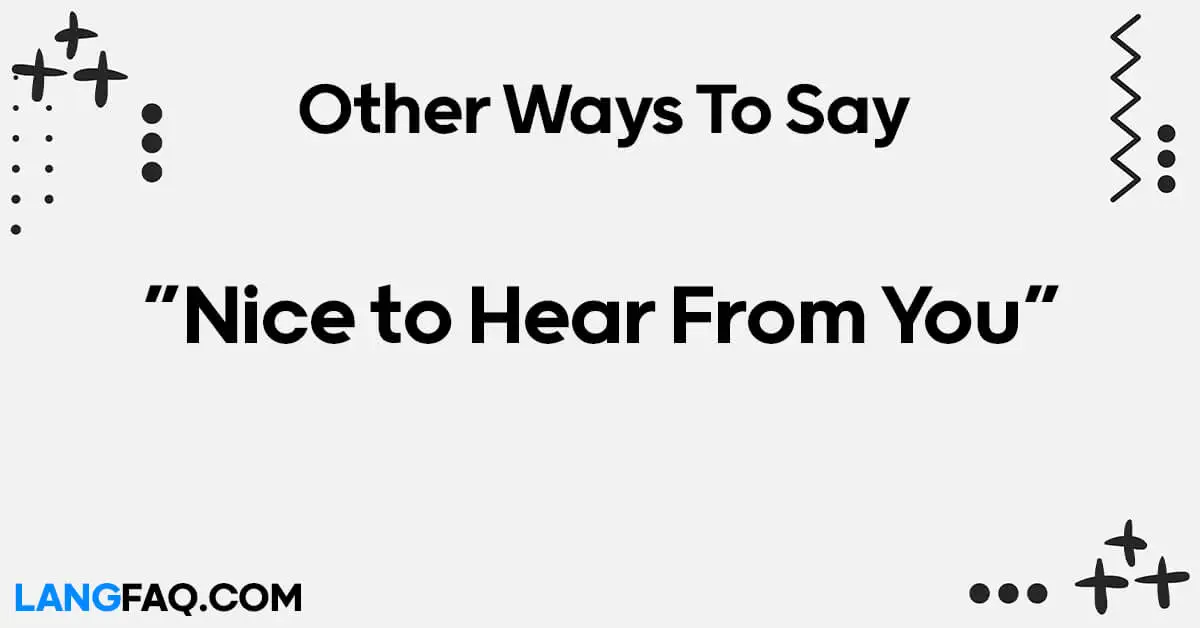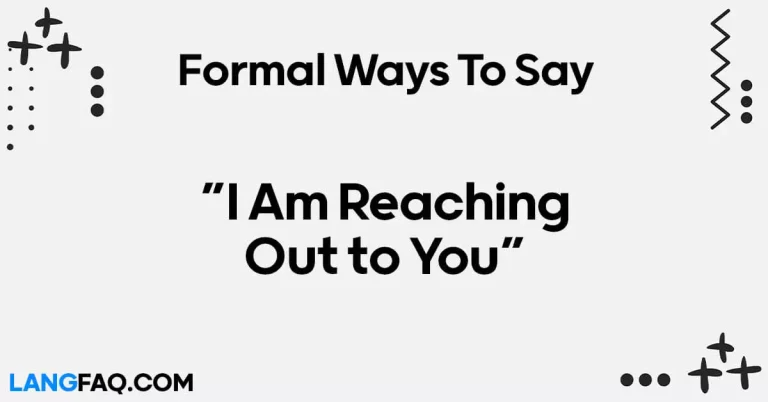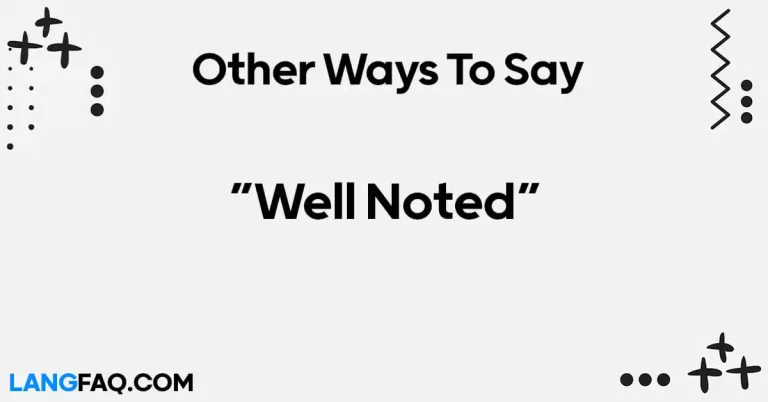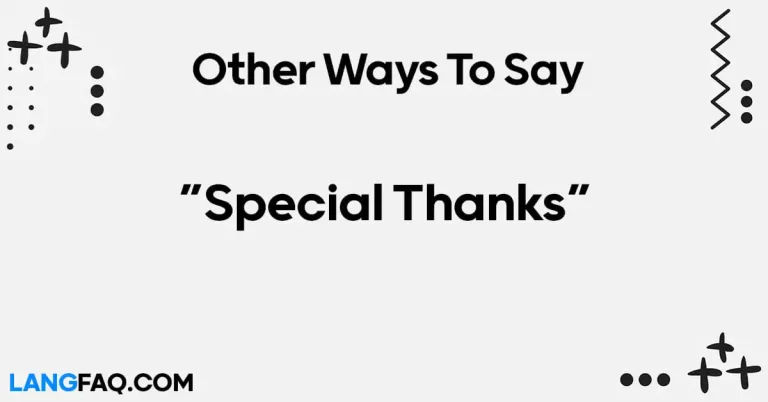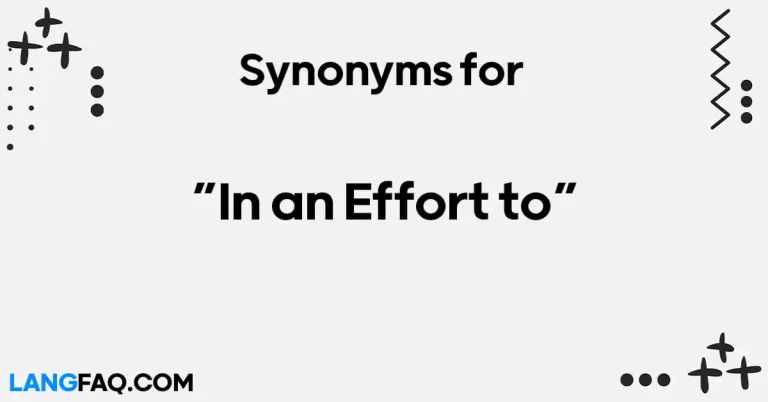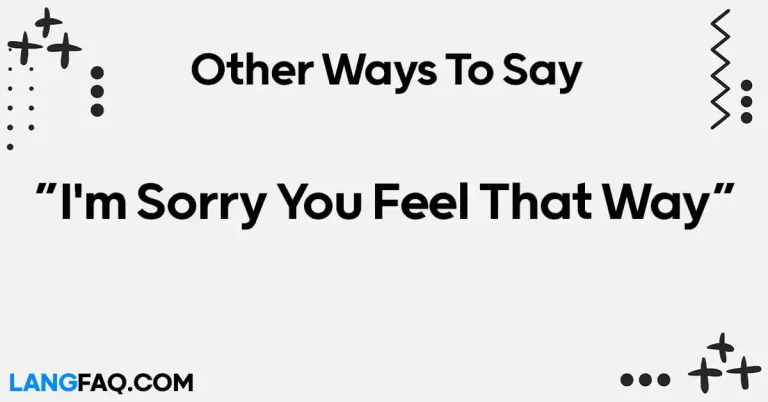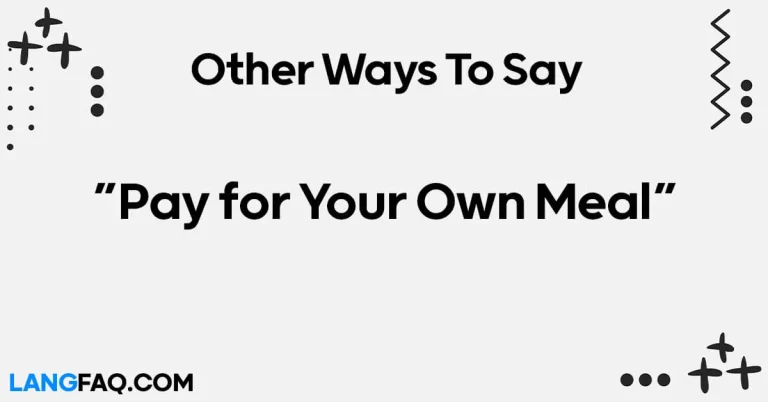In the ever-evolving digital landscape, communication is at the heart of every interaction. Whether it’s in the realms of business, personal relationships, or professional networking, expressing delight upon receiving a message is a courtesy that transcends boundaries.
While the phrase “Nice to hear from you” is undoubtedly polite, there are countless other expressions that can add depth and personality to your communication.
In this article, we explore 12 alternative ways to convey the same sentiment, helping you stand out and connect more authentically with your audience.
12 Other Ways to Say “Nice to Hear From You”
Here are 12 alternative ways to say “Nice to hear from you,” each with its unique tone and nuance:
- It’s a pleasure to receive your message: This expression adds a touch of formality while conveying appreciation for the message.
- I’m delighted to hear from you: This phrase exudes warmth and genuine happiness upon receiving the message.
- Your message brightened my day: It not only acknowledges the message but also highlights the positive impact it had on your mood.
- I’m thrilled you reached out: Expresses excitement and enthusiasm at the communication.
- It’s always a joy to hear from you: Conveys a longstanding and cherished connection.
- Your message made my day: Similar to #3, it emphasizes the message’s positive effect on your mood.
- I’m so glad you got in touch: Expresses happiness and appreciation for the sender’s effort to communicate.
- How wonderful to hear from you: Elicits charm and appreciation in a friendly manner.
- I’m grateful for your message: Conveys a deep sense of gratitude for the sender’s communication.
- Your message brought a smile to my face: Not only expresses happiness but also visualizes the positive reaction.
- I appreciate your outreach: Adds a formal touch while thanking the sender for reaching out.
- Your communication is always welcome: Ends on a welcoming note, inviting ongoing dialogue and collaboration.
These alternatives can help you convey your appreciation and enthusiasm in various contexts, whether in personal or professional communication.
1. Delighted to Receive Your Message
When it comes to responding to emails and messages, expressing enthusiasm and appreciation can go a long way in building positive relationships. “Delighted to receive your message” is a phrase that conveys both politeness and genuine delight.
When to Use:
- Professional Correspondence: This phrase is perfect for business-related emails, especially when you want to maintain a formal yet welcoming tone.
- Personal Connections: It’s also suitable for personal emails, particularly when you want to show your happiness at hearing from friends or family.
Example:
Dear [Client’s Name],
I wanted to express how delighted I am to receive your message regarding our upcoming project. Your prompt response and engagement truly demonstrate your commitment to our collaboration. I look forward to discussing the details further.
Tips:
- Use this phrase sparingly in professional contexts to maintain its impact.
- It’s suitable for both initial responses and follow-up emails when you want to reiterate your delight.
2. Thrilled to Hear from You
“Thrilled to hear from you” is a lively expression that communicates excitement and sets a positive tone for the conversation.
When to Use:
- Building Rapport: Use this phrase to establish rapport and enthusiasm when you’re starting a new conversation or relationship.
- Expressing Appreciation: It’s ideal for showing appreciation when someone reaches out with good news or important information.
Example:
Hi [Name],
I just wanted to drop you a quick note to say how thrilled I am to hear from you. Your insights on our recent project have been invaluable, and I’m looking forward to our meeting tomorrow to discuss them further.
Tips:
- Be mindful of context; reserve this phrase for situations where enthusiasm is genuinely warranted.
- It can be especially effective in business development and sales emails to create a positive first impression.
3. It’s Always a Pleasure
“It’s always a pleasure” is a timeless and gracious way to acknowledge a message, reflecting a long-standing and valued connection.
When to Use:
- Long-Term Relationships: Use this phrase when you have an established, ongoing relationship with the person you’re communicating with.
- Networking: It’s also fitting for professional networking to convey that you appreciate the continued communication.
Example:
Dear [Colleague’s Name],
It’s always a pleasure to receive your messages. Your insights and contributions to our team have been invaluable over the years. Let’s schedule a time to catch up and discuss our upcoming projects.
Tips:
- This phrase works well for maintaining and strengthening existing connections.
- Avoid using it in initial contact or when the relationship is still in the early stages.
4. Your Message Brightened My Day
Adding a personal touch to your responses can enhance the connection you have with the sender. “Your message brightened my day” not only expresses appreciation but also indicates a personal connection and emotional impact.
When to Use:
- Personal Relationships: Use this phrase when communicating with friends, family, or close colleagues to show the emotional impact of their message.
- Positive News: It’s especially appropriate when the message contains good news or uplifting content.
Example:
Hey [Friend’s Name],
Just wanted to let you know that your message brightened my day. Hearing your news about the promotion made me genuinely happy for you. Let’s celebrate soon!
Tips:
- Reserve this phrase for messages that genuinely had a positive impact on your mood.
- It’s great for nurturing personal relationships but may be too emotional for professional settings.
5. I’m Ecstatic You Reached Out
When you want to express sheer joy and excitement upon receiving a message, “I’m ecstatic you reached out” is a vibrant choice. This phrase radiates happiness and enthusiasm.
When to Use:
- Celebratory Occasions: Use this phrase for messages related to achievements, milestones, or events that warrant celebration.
- Friendly Conversations: It’s suitable for casual and friendly conversations when you want to express your genuine delight.
Example:
Hi [Friend’s Name],
I’m ecstatic you reached out! Your invitation to the concert couldn’t have come at a better time. Count me in, and let’s rock the night away!
Tips:
- Use this phrase sparingly to maintain its impact; it’s not suitable for everyday correspondence.
- It’s best reserved for personal conversations or interactions with close colleagues and friends.
6. Thank You for Getting in Touch
Expressing gratitude is always appreciated, and “Thank you for getting in touch” does just that. It’s a polite way to acknowledge the effort taken to reach out.
When to Use:
- Professional Communication: This phrase works well in professional emails, especially when you want to convey your gratitude for inquiries, feedback, or requests.
- Customer Relations: It’s a valuable response in customer service to thank customers for reaching out with questions or concerns.
Example:
Dear [Customer’s Name],
Thank you for getting in touch with us regarding your recent order. We appreciate your business and are here to assist you with any questions or issues you may have.
Tips:
- Use this phrase as a starting point to address the sender’s needs or concerns.
- It’s a versatile expression suitable for various business contexts.
7. Your Message Made My Day
Similar to the fourth phrase, “Your message made my day” highlights the positive impact of the message. It’s a straightforward and heartfelt way to convey your appreciation.
When to Use:
- Personal Touch: Use this phrase in personal messages when you want to express how the sender’s communication positively affected you.
- Informal Business Communication: It can also work in business emails when you want to maintain a friendly tone with colleagues or clients.
Example:
Hello [Name],
I just had to let you know that your message made my day. Your kind words and encouragement mean a lot to me, and I’m truly grateful for your support.
Tips:
- Use this phrase when you genuinely feel that the message brightened your day.
- It’s suitable for both personal and informal professional exchanges.
8. How Lovely to Hear from You
Evoke a sense of charm and appreciation with “How lovely to hear from you.” This phrase is perfect for expressing genuine delight.
When to Use:
- Friendly and Polite: Use this phrase when you want to maintain a friendly and polite tone in your message.
- Casual and Social: It’s suitable for casual emails, social interactions, and friendly conversations.
Example:
Hi [Friend’s Name],
How lovely to hear from you! Your invitation to the barbecue this weekend sounds fantastic. I can’t wait to catch up and enjoy some delicious food.
Tips:
- This phrase is ideal for maintaining a warm and friendly atmosphere in your communication.
- It’s versatile and can be used in both personal and informal professional contexts.
9. I Appreciate Your Outreach
When you want to maintain a more formal tone in your response, “I appreciate your outreach” is an excellent choice. This phrase conveys gratitude and professionalism.
When to Use:
- Professional Settings: Use this phrase in business emails or when responding to professional inquiries.
- Acknowledging Effort: It’s ideal for situations where you want to acknowledge and thank someone for taking the initiative to reach out.
Example:
Dear [Client’s Name],
I appreciate your outreach regarding the upcoming project. Your interest and engagement are crucial to its success, and I’m looking forward to our collaboration.
Tips:
- This phrase adds a touch of formality to your response, making it suitable for business interactions.
- It works well in initial responses or as a follow-up when you want to maintain professionalism.
10. Your Message Brought a Smile to My Face
To convey not only happiness but also a visual representation of your feelings, say, “Your message brought a smile to my face.”
When to Use:
- Visual Impact: Use this phrase when you want to create a vivid image of your reaction to the message.
- Warmth and Positivity: It’s suitable for expressing warmth and positivity in personal or friendly emails.
Example:
Hello [Friend’s Name],
I had to share that your message brought a smile to my face. Your humor and wit always brighten my day. Let’s catch up soon!
Tips:
- Use this phrase when the sender’s message genuinely made you smile.
- It’s ideal for personal and informal interactions.
11. I’m Grateful for Your Message
Gratitude is a powerful emotion. Express it sincerely with, “I’m grateful for your message,” to create a meaningful connection.
When to Use:
- Emotional Depth: Use this phrase when you want to convey deeper gratitude and appreciation.
- Formal Thank You: It’s suitable for more formal thank-you messages or expressions of appreciation.
Example:
Dear [Name],
I wanted to let you know how much I’m grateful for your message. Your support during a challenging time has meant the world to me.
Tips:
- Reserve this phrase for situations where you genuinely feel a strong sense of gratitude.
- It’s suitable for both personal and professional communication.
12. Your Communication is Always Welcome
End on a welcoming note with, “Your communication is always welcome.” This phrase expresses an ongoing invitation for dialogue and collaboration.
When to Use:
- Open Invitation: Use this phrase to maintain an open and welcoming line of communication.
- Customer Relations: It’s effective in business contexts to assure customers or clients that their feedback and inquiries are valued.
Example:
Hello [Customer’s Name],
Your feedback is essential to us, and your communication is always welcome. Please feel free to reach out with any questions or suggestions.
Tips:
- Use this phrase to encourage ongoing interaction and engagement.
- It’s a great way to build trust and rapport with customers, colleagues, or contacts.
Incorporating these alternative phrases into your email responses can elevate your communication and help you express your thoughts and feelings more authentically. Remember to choose the phrase that best suits the context and your relationship with the sender, enhancing your overall communication effectiveness.
In conclusion, while “Nice to hear from you” is a courteous way to respond to messages, there are myriad alternatives to choose from, each with its unique tone and nuance. Tailor your response to the context and your relationship with the sender to create a more meaningful and engaging conversation.
Is It Correct to Say “Nice to Hear From You”?
Yes, it is correct to say “Nice to Hear From You.” This phrase is a polite and common way to express your appreciation when someone reaches out to you or contacts you.
It conveys a sense of warmth and friendliness, indicating that you are pleased to receive their message or communication.
However, if you’re looking for alternative expressions to use in different situations to make your responses more engaging and expressive, you can explore the 12 other ways mentioned in the article above.
FAQ
How can I make my responses more meaningful?
Personalize your responses and use expressions that convey genuine appreciation and interest.
Is it essential to respond to every message?
While it’s polite to respond, consider the context and your relationship with the person.
Can I use these alternatives in professional emails?
Absolutely! These expressions can enhance your professionalism and leave a positive impression.
What if I don’t feel enthusiastic about the message?
Focus on the positive aspects and find something genuine to appreciate in the message.
Should I use these alternatives in formal communication?
It depends on the formality of the situation. Some expressions may be more suitable for informal settings.
How can I remember to use these alternatives?
Practice incorporating them into your responses until they become second nature.

